- Author Matthew Elmers [email protected].
- Public 2023-12-16 21:49.
- Last modified 2025-01-24 09:17.
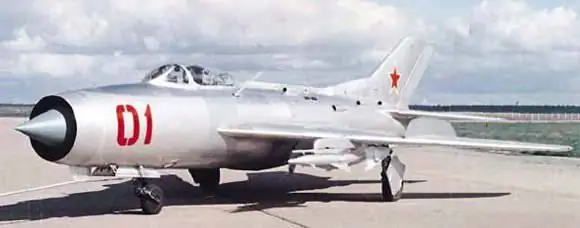
During the development of the MiG-21, the quite successful MiG-19 fighter was put into production. He became the first serial supersonic fighter in the world. The MiG-19 was the first to solve many problems associated with supersonic flights. The only design flaw of the aircraft was the subsonic air intake. As you know, the air intake device significantly affects the flight characteristics of the aircraft. The less the total pressure loss of the air entering the engine, the higher its thrust, and hence the higher the characteristics of the aircraft. At a flight speed corresponding to Mach 1, 5, the thrust loss of an engine with a subsonic air intake reaches 15%. Air intakes with a rounded shell used on the MiG-15, MiG-17 and MiG-19, which created a suction force at subsonic speeds, significantly increased drag at supersonic speeds. But, it should be noted that at the time of the creation of the MiG-19, world science was still groping for the basic laws of supersonic aerodynamics, and therefore the first created, the MiG-19, was slightly ahead of the birth of the complete theory of supersonic input devices. Considering the rapid development of aviation at that time, it was quite natural to demand that work to improve the flight technical data of the MiG-19S aircraft be carried out by OKB-155 on December 12, 1956 by order of the Ministry of Aviation Industry No. 60 7. And in the spring of 1957, the fighter entered flight tests SM-12 is another modification of the MiG-19S. The first vehicle, SM-12/1, was converted at plant No. 155 from a high-altitude MiG-19SV (No. 61210404). On it, first of all, the air intake was replaced with a new one, with a sharp shell and a central body (cone). It was also planned to supply more powerful experimental RD-9BF-2 engines with the prospect of further installation of RD-9BF-2 with water injection. An SRD-1M radio range finder coupled with an ASP-4N optical sight was placed in the central body of the air intake. But due to delays in the fine-tuning of the forced engines, it was necessary to be content with the serial RD-9BF.
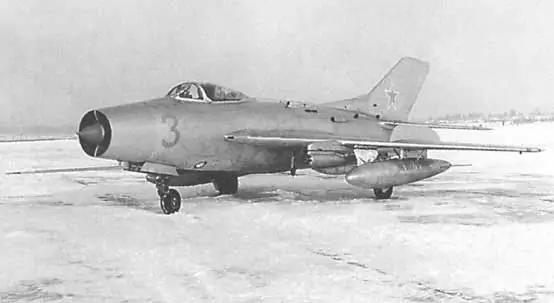
In this form, the SM-12 began factory flight tests in April. Apparently, the first flight and the bulk of these tests were performed by the pilot K. K. Kokkinaki. After 15 flights, tests of the SM-12/1 were continued with the RD-9BF-2 engines, but in the fall the car was put back for revision. This time it was equipped with, as it seemed then, more promising engines P3-26. The RZ-26 engine with increased afterburner thrust (3800 kg) at high flight altitudes, developed at OKB-26, was a modification of the RD-9B engine. On it, constructive improvements were carried out in order to increase the reliability of switching on the afterburner at high altitudes and to increase the stability of operation in variable modes.
The first copy, designated SM - 12/1, which previously carried out the test program with the RD-9BF and RD-9BF-2 engines, was equipped with new engines and sent to factory flight tests on October 21, 1957. Almost in parallel with this machine, the second MiG was being finalized -19С for RD-9BF-2 engines with water injection system. In general, this machine, which received the designation SM-12/2, was just intended to fine-tune this engine, but by the summer of 1958 it had not entered the experimental OKB plant, and the P3-26 engines were installed instead.
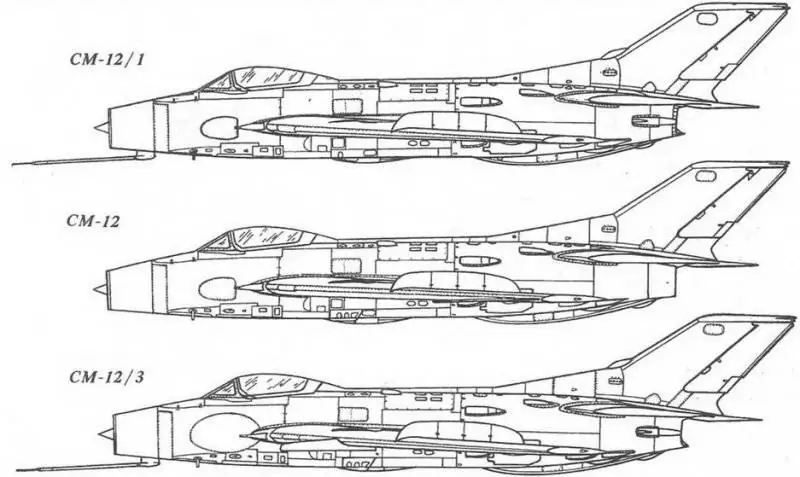
The next sample CM - 12/3 was already a standard for mass production and therefore the full scope of all design changes was carried out on it. The aerodynamics of the aircraft was improved through the use of a supersonic diffuser with an automatically controlled on-off cone at the entrance to the air intake channel, in connection with which the nose of the fuselage was lengthened by 670 mm. Also installed hydraulic boosters with semi-connected spools BU-14MSK and BU-13MK instead of BU-14MS and BU-13M, and to improve reliability, the hydraulic booster control system was improved - they excluded non-duplicated sections of hydraulic systems for boosters and all rubber hoses were replaced with steel hoseless connections. In addition, the SM - 12/3 was equipped with the SRD-5 "Baza-6" radio rangefinder instead of the SRD-1M. The rest of the aircraft equipment and its components remained the same as on the serial MiG-19S. All of the above improvements naturally led to an increase in the weight of the aircraft, which is why the designers had to leave only two HP-30 wing cannons with 73 rounds of ammunition on the aircraft, and the lengthening of the nose of the fuselage also made it possible to remove the localizers from them. To maintain the alignment of the SM-12/3 aircraft, the installation of beams for the suspension of the ORO-57K blocks was changed on it, which were placed in the front part of the wing in order to shift the aircraft's center of gravity forward. The take-off weight of the SM-12/3 aircraft, as a result of the structural changes, even with the fuselage cannon removed, increased by 84 kg compared to the take-off weight of the serial MiG-19S.
On December 19, 1957, SM - 12/3 and SM - 12/1 were presented to the Air Force Research Institute for state flight tests in order to take basic flight technical data and determine the possibility of adopting the SM - 12 aircraft for service with the Air Force. In accordance with the order of the Commander-in-Chief of the Air Force, the Air Force Research Institute on April 15, 1958 presented a preliminary conclusion on the possibility of launching the SM-12 aircraft into serial production. During the state tests, 112 flights were performed on the SM-12/3 aircraft and 12/1 -40 flights on the SM. During tests on the SM-12/3 fighter, RZ-26 engines with fuel dump valves were installed to prevent the engines from turning off when firing rockets, and the tail section of the fuselage was also modified to improve the temperature conditions of its operation. During the tests, SM - 12 showed excellent speed, acceleration and altitude characteristics. The maximum horizontal flight speed with engines running on afterburner at an altitude of 12,500 m was 1926 km / h, which is 526 km / h more than the maximum speed of the serial MiG-19S at the same altitude (at an altitude of 10,000 m, the speed advantage was 480 km / h.
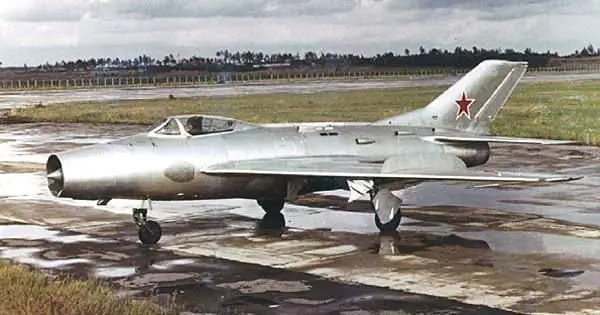
The acceleration time at an altitude of 14000 m from a speed corresponding to the number M = 0.90 to a speed of 0.95 from the maximum was 6.0 min (fuel consumption 1165 kg), and the acceleration time at the same altitude to 0.95 of the maximum horizontal speed The flight of the MiG-19S aircraft was two times less and amounted to 1.5 minutes instead of 3.0 minutes for the MiG-19S. Fuel consumption in this case on the SM - 12 aircraft is 680 kg, and on the MiG-19S - 690 kg.
During acceleration in horizontal flight with outboard fuel tanks with a capacity of 760 liters, at an altitude of 12,000 m, the number M = 1, 31-1, 32 was reached, which practically corresponded to the maximum speed of the MiG-19C without tanks. The behavior of the SM-12 aircraft was normal. True, during the acceleration of the aircraft at altitudes below 10,000 m with the engines running on afterburner, the sequence of fuel production from the tanks was disrupted, which could lead to the full depletion of fuel from the first tank in the presence of fuel in the third and fourth tanks, which violated the alignment of the aircraft with all the ensuing consequences …
The practical ceiling of the SM - 12 in afterburner with the climb mode at subsonic speed (M = 0.98) was 17,500 m, which is 300 m higher than the practical ceiling of the production MiG-19S aircraft in the same climb mode. At the same time, the set time and fuel consumption of the SM-12 remained practically the same as on the MiG-19S. However, on the practical ceiling in the subsonic flight mode on the SM-12 aircraft, as on the MiG-19S, only horizontal flight was possible. Performing even minor maneuvers resulted in a loss of speed or altitude.
The practical ceiling of the SM-12 aircraft at supersonic flight speed (M = 1, 2) also amounted to 17,500 m, although the fuel consumption increased by 200 liters. But in flight on the ceiling in supersonic mode, the SM - 12 already had the ability to perform limited maneuvering in the horizontal and vertical planes with a roll of no more than 15-25 °.
In addition, the SM-12 aircraft, in comparison with the serial MiG-19S, had higher dynamic qualities due to the fact that it could reach high flight speeds. So, in flight with a climb and acceleration in the process of climbing to M = 1.5 to an altitude of 15,000 m, an aircraft with a decrease in speed could briefly reach an altitude of up to 20,000 m at supersonic speed (M = 1.05). The remaining fuel when reaching an altitude of 20,000 m was 680 liters.
Naturally, the "gluttony" of the RZ-26 engines when operating at afterburner and the increased fuel consumption led to the fact that the SM-12 lost to the MiG-19S in flight range, since the fuel supply (2130 liters) remained unchanged. As a result, the maximum practical flight range without outboard tanks at an altitude of 12000 m decreased from 1110 km to 920 km, i.e. by 17%. Two 760-liter outboard tanks filled with 600 liters each, although they made it possible to increase it to 1530 km, but this was 260 km less than on the production MiG-19C aircraft.
In addition, after acceleration in horizontal flight at an altitude of 12000-13000 m to a maximum speed equal to 1900-1930 km / h, the fuel reserve remained no more than 600-700 liters, which reduced the possibility of using speeds close to maximum.
When flying on afterburner away from the airfield with the condition of landing on its own airfield with 7% fuel remaining (150 liters), the SM-12 aircraft without outboard tanks could reach a speed of 1840 km / h at an altitude of 14000 m (less than the maximum speed at this altitude at 60 km / h), but could not continue further flight at this speed. At the same time, the plane left the departure airfield at a distance of about 200 km.
Take-off and landing characteristics (without outboard tanks and with retracted flaps) have changed not for the better. The length of the takeoff run and takeoff distance (up to a climb of 25 m) of the SM-12 aircraft with the afterburner on during the takeoff was 720 mi 1185 m, respectively, versus 515 m and 1130 m for the MiG-19S, and with the inclusion of the maximum on the takeoff run - 965 m and 1645 m for the SM - 12 and 650 m and 1525 m for the MiG-19S.
Due to the high temperature regime in the tail section of the fuselage, the technical staff serving the aircraft had to more thoroughly inspect the tail section of the fuselage for burnouts, warpage and monitor the presence of uniform gaps between the engine extension tube and the fuselage screen.
Nevertheless, the RZ-26 engines themselves showed their best side over the entire testing period. During climb, in level flight and during planning, they worked steadily in the entire operating range of changes in altitudes and flight speeds of the SM-12 aircraft, as well as when performing aerobatics, including with short-term action of negative and close to zero vertical overloads (without signs oil starvation).

Surge stability margin at afterburner and maximum modes during tests was at least 12, 8-13, 6%, which corresponded to the best world level. However, in connection with the use of aluminum alloy blades of 2-5 compressor stages on RZ-26 engines, the military demanded that the Chief Designer of OKB-26 take constructive measures to ensure the stability of the surging characteristics of RZ-26 engines as the resource was depleted.
RZ-26 engines also worked steadily during throttle response tests from idle to nominal, maximum or afterburner modes and when throttling from these modes to idle on the ground and in flight at altitudes up to 17000 m with smooth and sharp (for 1, 5 -2, 0 sec) movements of the control levers.
The engine afterburner was reliably switched on to altitudes of 15500 m at speeds of 400 km / h on the instrument and more, which expanded the combat capabilities of the SM-12 aircraft at high altitudes compared to the MiG-19S aircraft. Thus, the main operating parameters of the engines in all cases were within the technical specifications. The military did not have any special complaints about the operation of the engines, which cannot be said about the system for starting them. So the launch of the RZ-26 engines on the ground turned out to be much worse than the RD-9B on the MiG-19S aircraft. At temperatures below -10 C, launch was possible only from the APA-2 airfield unit. Autonomous engine start at subzero temperatures is practically impossible, and engine start, in particular the start of the second engine with the first engine running, from the 12SAM-28 onboard battery, as well as from the ST-2M launch bogie, was unreliable even at positive ambient temperatures. In this regard, the military demanded that OKB-26 and OKB-155 take measures to improve reliability, ensure autonomy and reduce the time for launching RZ-26 engines on the ground. The engines were launched in flight reliably at an altitude of 8000 m at an instrument speed of more than 400 km / h, and at an altitude of 9000 m at an instrument speed of more than 500 km / h.
On the SM-12 aircraft, stable operation of the RZ-26 engines was ensured when firing from NR-30 cannons without localizers at altitudes up to 18,000 m and firing S-5M rockets without using fuel discharge valves at altitudes up to 16,700 m. To check the stability of the engines RZ-26, when firing S-5M projectiles from ORO-57K blocks, firing was carried out under all possible flight conditions. In all flights with serial salvo firing with S-5M projectiles and firing from NR-30 cannons without localizers, the RZ-26 engines with disabled fuel discharge valves work steadily. The number of revolutions and the temperature of the gases behind the turbine of the engines did not practically change during firing. This indicated that it was inexpedient to install fuel dump valves on RZ-26 engines when using 12 S-5M rockets from 4 ORO-57K units on a SM aircraft. The characteristic of technical dispersion when firing at a shooting range and the stability of the zeroing of the cannon armament corresponded to the requirements of the Air Force, and did not exceed two thousandths of the range. However, when firing from the cannons at numbers M = 1, 7, the SM - 12 aircraft had significant roll oscillations and somewhat smaller pitch angles, which could not be countered by the deviation of the controls, since the aircraft began to wobble even more. Naturally, this negatively affected the accuracy of shooting.
The jet armament also worked reliably during testing. The recoil force during serial-salvo firing with 32 S-5M rockets (4 rounds in each salvo) was felt much less than when firing from the NR-30 cannons. However, the ASP-5N-V4 sight installed on the aircraft could not provide the required firing accuracy with S-5M projectiles, which reduced the effectiveness of the combat use of jet weapons.
The range of the SRD-5A radio range finder did not ensure the use of the entire range of the range worked out by the sight (up to 2000 m). If the range of the radio range finder on the MiG-19 aircraft during attacks from an angle of 0/4 was 1700-2200 m, then during attacks from an angle of 1/4 or more, only 1400-1600 m. At the same time, tracking along the range was carried out steadily. No false captures by the radio range finder at the moment of firing from the cannons were noted. The radio range finder also worked steadily on the ground from an altitude of 1000 m. The range of the Sirena-2 tail protection station when attacked by a Yak-25M aircraft with an RP-6 radar sight from the rear hemisphere with an angle of 0/4 was 18 km, which met the requirements of the Air Force.

According to the leading test pilots and fly-over pilots, the SM-12 fighter practically did not differ from the MiG-19S aircraft in its piloting technique in the entire range of operating speeds and flight altitudes, as well as during takeoff and landing.
The stability and controllability of the SM-12 aircraft in the range of operating speeds and flight altitudes are basically similar to the stability and controllability of the MiG-19S, except for the instability in overload that is more pronounced compared to the MiG-19S at transonic flight speeds at high angles of attack. The instability in overload was manifested to a greater extent in the presence of external suspensions or with released air brakes. braking. At the same time, the implementation of vertical and horizontal aerobatics on the SM-12 aircraft is similar to their performance on the MiG-19S aircraft. Coordinated sliding could be performed in the entire range of speeds and M numbers, while the roll at high indicated speeds and M numbers did not exceed 5-7 °.
The flights to check the emergency electrical control of the stabilizer were performed at instrument speeds of up to 1100 km / h at altitudes of 2000-10000 m and up to M = 1, 6 at altitudes of 11000-12000 m. Piloting the aircraft at the same time required more accurate movements from the pilot. the control stick, especially in the range of numbers M = 1, 05-1, 08. Inaccuracy of the control stick movement could lead to the swinging of the aircraft. In the opinion of the test pilots, taking into account all the above advantages and disadvantages of the SM-12 aircraft compared to the MiG-19S, it was advisable to recommend it for adoption by the Air Force units instead of the MiG-19S, subject to the elimination of the identified defects.
In this regard, the GK NII VVS asked the Chairman of the State Committee of the Council of Ministers of the USSR for aircraft engineering to oblige OKB-155 to work out a sample of the SM-12 aircraft for serial production and present it for control tests before launching into a series, with the necessary modifications to be made on it.
But it didn't have to be done. The leadership of the MAP unreasonably considered that the reserves of the vehicle had already been exhausted, and there was no point in improving it.
In addition, at this time, the prototype of the MiG-21 fighter was already successfully tested, which had higher characteristics than the aircraft of the "SM" family. In general, everything suggests that the work on the SM-12 and its modifications was carried out for safety reasons, in case of failure with the future MiG-21.
Nevertheless, the history of the SM - 12 fighters did not end there. Subsequently, the SM - 12/3 and SM - 12/4 aircraft made a significant contribution to the development of the K-13 guided missiles, which were subsequently in service with fighter aircraft for a long time.
As you can see, the only drawback of the SM-12 aircraft was the short flight range, especially in afterburner mode. This drawback was a consequence of the gluttony of the RZ-26 engines used on it. However, it should be noted that much later in China, a supersonic air intake with a fixed central body was also installed on the MiG-19. The aircraft received the name J-6HI and with RD-9 engines developed a speed of up to 1700 km / h.
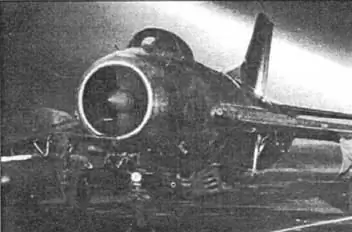
Chinese J-6HI
Compared to its Chinese counterpart, the SM-12 had a more progressive, input device, as well as improved aerodynamics. Therefore, it can be argued that with standard RD-9, SM-12 engines, it could reach a speed of about 1800 km / h, while maintaining a range of 1300 km. Thus, on the basis of the MiG-19, OKB-155 managed to create a completely successful fighter capable of withstanding any American machines of the "hundredth" series, i.e. fulfill the basic requirements for the MiG-21.
The performance characteristics of the SM-12/3
Wingspan, m 9.00
Length, m 13.21
Height, m 3.89
Wing area, m2 25.00
- an empty plane
- maximum takeoff 7654
- fuel 1780
Engine type 2 TRD R3M-26
Thrust, kgf 2 x 3800
Maximum speed, km / h 1926
Practical range, km
- normal 920
- with PTB 1530
Rate of climb, m / min 2500
Practical ceiling, m 17500
Max. operational overload 8
Crew, people 1
References:
Aviation and Astronautics 1999 07
Efim Gordon. "The first Soviet supersonic"
Wings of Russia. "History and aircraft of OKB" MiG"
Wings of the Motherland. Nikolay Yakubovich. "Fighter MiG-19"
Aviation and Time 1995 05
Nikolay Yakubovich "The first supersonic fighters MiG-17 and MiG-19"






